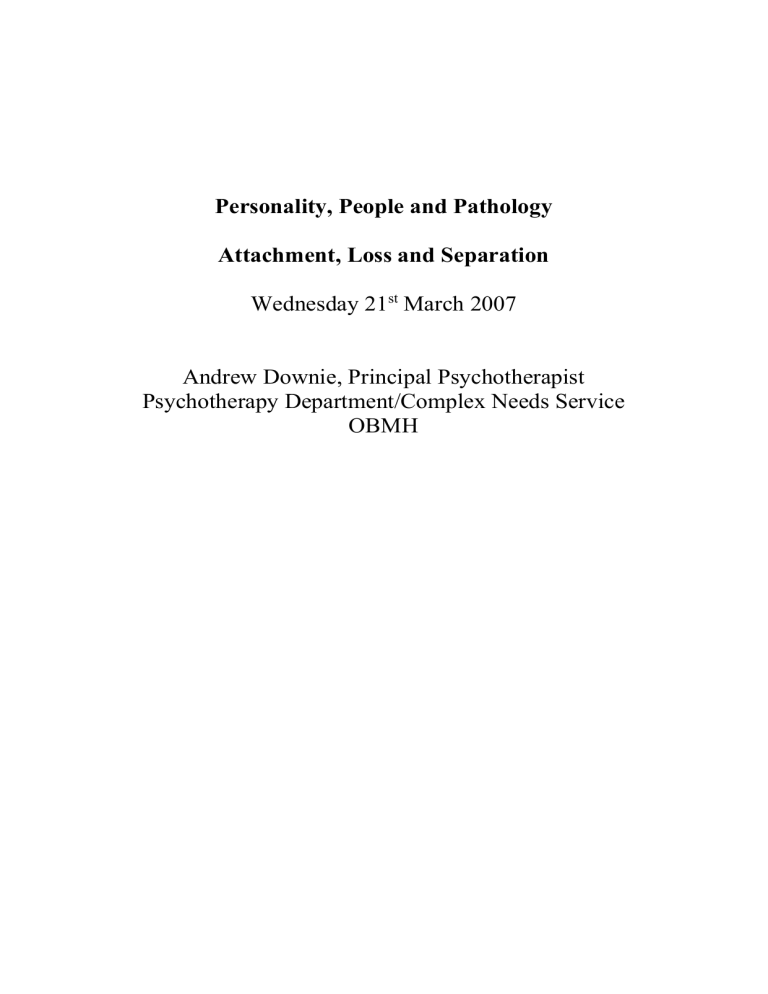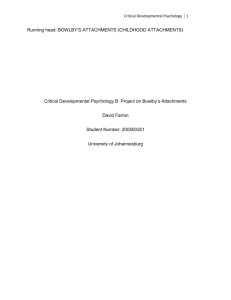Personality, People and Pathology

Personality, People and Pathology
Attachment, Loss and Separation
Wednesday 21
st
March 2007
Andrew Downie, Principal Psychotherapist
Psychotherapy Department/Complex Needs Service
OBMH
Attachment Theory in Context
There’s nothing so practical as a good theory…
Psychodynamic/psychoanalytic theories: concern with motivational drives and conflict
Freud: sexual/aggressive drives – emphasis on
‘intrapsychic’ processes – psychic reality more important than historical reality
Object Relations School: primary drive is to seek relationships
Attachment Theory – Bowlby: we seek relationships for protection, safety – response of caregiver to this seeking crucial to development
Emphasis on the role of environmental factors – deprivation, loss and separation.
Context Continued…
Struggle for theory to be accepted: ‘What about phantasy?’
But clearly part of a move from emphasis on intrapsychic processes to interpsychic, to interpersonal: from nature to nurture.
Parallel move in psychotherapy: increasing emphasis on the relationship – the therapeutic alliance.
Attachment Theory as a more ‘concrete’ theory, based on observation rather than inference
Bowlby’s influence: shift in public policy – residential day nurseries; parents staying with children in hospital
Theory developed by research
John Bowlby
Lived 1907-1990
A seasick sailor
Entered medical training, then psychoanalysis, intending to be a child psychiatrist.
Trained in child analysis with Melanie Klein
Became aligned with others interested in the impact of the environment, including WH Rivers of ‘Regeneration’ fame.
Came to see importance of: instinct for self-preservation; also boned between mother and child.
Wrote ‘Forty-four juvenile thieves’ – the affectionless psychopath.
Post-war : WHO – mental health of homeless children – leading to ‘Child Care and the Growth of Love’ (1953): maternal deprivation.
Attachment Theory: blending psychoanalytic theory with
Ethology
The Big Three : ‘Attachment’ (1969), ‘Separation’ (1975),
‘Loss’ (1980)
What is attachment theory?
A primary motivational system – not related to feeding, etc.
Purpose: safety, protection from environmental threat
Describes the emotional bond between people, where one
(usually) is perceived to be wiser, stronger
A spatial theory, characterised by proximity seeking
Secure attachment allows exploration: the secure base
Loss of attachment leads to separation
Lack of resolution leads to disturbance in development
In longer term, if no adequate developmental pathway is available, disturbance likely to persist through the life cycle.
The disturbance is the result of the environmental failure, plus the sense the individual makes of it.
The Secure Base
Ainsworth (1982) : term used to describe the feeling of safety created in the child by the caregiver
Child will venture away from caregiver, explore, return at times of stress/threat
Persists throughout life cycle: ‘All of us, from the cradle to the grave, are happiest when life is organised as a series of excursions, long or short, from the secure base provided by our attachment figures.’
depends on caregiver’s/child’s interactions: caregiver’s capacity to be attuned to the child’s feelings; to contain those feelings; to give them back to the child in a form the child can manage.
Development of Attachment Behaviour
0-6 months: new born does not discriminate between caregivers o but responsive to contact o evoking a smile (attunement again) – baby’s nascent capacity to initiate an interaction – sense of agency, effectiveness.
6 months – 3 years: baby begins to show stranger anxiety – ‘Not the mummy’. Beginning to explore environment, beginning of internal working model.
3 years + : development of language. Child can think of parents as separate people, own goals, own minds
(mentalization) – more sophisticated attachment seeking behaviour
Adolescence: breaking of attachment bonds, via the group, on to pairing
Adult attachment: finding partners
Stages in Separation and Loss
Child: o Protest o Despair o Detachment/Denial
Four phases of mourning: o Numbing o Yearning, searching, anger o Disorganisation and disrepair o Re-organisation
Attachment Theory and Personality Disorder
Looking at Borderline PD, studies suggest high levels of emotional neglect and trauma
Affect regulation: our ability to manage our own feelings, to think about them; and the feelings of others
– our minds and others’ minds – mentalization.
Infant’s sense of self depends on affective quality of relationship with caregivers
Ability of caregiver to tune in to infant’s feelings, to manage them, give them back – attunement, holding, containing.
Insecure attachment is likely to result from these failures
Will lead to development of an internal working model along lines of: I am not worthy of love, others are not capable of giving it – but a yearning for what has been missed (mourning).
Internal/external conflict: ‘I hate you, don’t leave me!’








